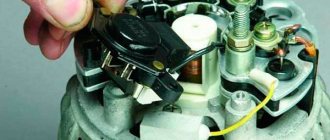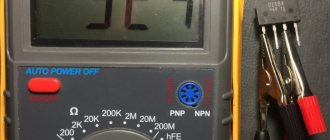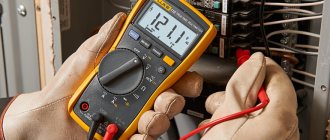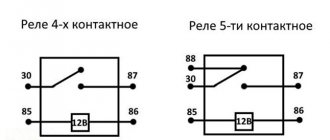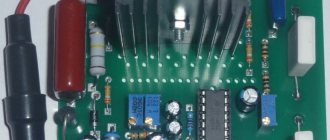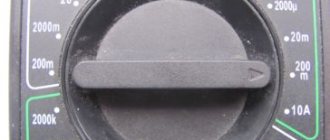Why do you need a voltage regulator in a car?
This small, simple device performs an important function - voltage regulation. That is, if the voltage is greater than set, the regulator should reduce it, and if the voltage is less than set, the regulator should raise it.
What voltage does the generator relay regulate?
When the engine is running, the generator operates, which generates and transmits electric current to the battery.
If the voltage regulator does not work correctly, the car battery quickly drains its life. The regulator is sometimes called a pill or a chocolate bar.
Checking the voltage relay
Car battery charging time calculator
Online calculation of battery charging time. Calculator for calculating how long you need to charge your car battery with a charger
Checking the generator voltage regulator may be necessary when problems with the battery begin to occur. In particular, it began to undercharge or overcharge. When such a malfunction occurs, it’s time to check the generator voltage regulator relay.
The relay should turn off at 14.8 V
The task of this simple device is to regulate the voltage of the electric current that is supplied from the generator to the battery. When it fails, the battery is either not charged enough or, on the contrary, overcharged, which is also dangerous, since this significantly reduces the battery life.
Agree that such a prospect is not very good because of one small detail. This is why it is so important to monitor the operating condition of the voltage regulator (it can also be called a pill or a chocolate bar). But in order to properly check the voltage regulator, you need to know its type and several important features.
Types and types of relay regulators
Depending on the type of relay, the method for determining performance also depends. Regulators are classified into 2 types:
Combined relays - this means that the relay itself with the brush assembly is located in the generator housing.
Separate relays - this means that the relay is located outside the generator housing and is mounted on the car body. You've probably seen a small black device attached to the fender of the car, wires go to it from the generator, and from it to the battery.
A distinctive feature of regulators from other devices is that the relays consist of a non-separable housing. During assembly, the body is glued with sealant or special resin. There is no point in disassembling and repairing it, since such electrical appliances are inexpensive.
Why does the generator fail?
The generator box contains a stator, which is the stationary part, and a rotor, which rotates. There is also a relay-regulator, winding, brushes and bearings. All these components can cause generator failure:
- The most common reason is when the bearings jam. This happens because over time dust and dirt get into the generator housing. But the bearing does not always “catch the wedge”; sometimes it can only wedge. This is not difficult to determine; if the rod stops rotating completely, then this indicates the first case. And if it still scrolls and then can stop, this means that the bearing is jammed.
- The electric winding of the rotor or stator may burn out if moisture penetrates there. Copper wires can short out or corrode, stopping the production of electrical current.
- Wear of brushes running along the magnetic paths of the stator. They are presented in the form of graphite rods that simply need to be changed.
- The regulator can also cause damage to this device. In this case, the generator is not able to recharge, or charging does not reach the battery at all. These are the main reasons why a generator breaks down, so when buying one you should always pay attention to these details.
Signs of trouble
If the voltage is low, the battery will not be able to charge. Thus, the battery will quickly run out.
If, after the relay-regulator, the voltage goes to the battery at a high level (higher than set), the electrolyte will begin to boil and evaporate. At the same time, a white coating appears on the battery.
What signs of a breakdown of the car generator voltage regulator may be:
- After turning the ignition key, the warning lamp does not light up.
- After the engine starts, the battery indicator does not go out on the instrument panel.
- In the dark, you can observe how the light becomes brighter and dimmer.
- The car's internal combustion engine does not start the first time.
- If the engine speed exceeds 2000, then all the dashboard lights may turn off.
- Loss of engine power.
- Battery boiling.
Causes of relay malfunction
The reasons include the following observations:
- Short circuit (SC) on any line of automotive electrical wiring.
- Diodes are broken. The rectifier bridge has closed.
- The battery terminals are not connected correctly.
- Water got inside the relay.
- Mechanical damage to the housing.
- Brush wear.
- The relay resource has expired.
Useful tips
Always try and alternator clean Since contacts often oxidize due to moisture. And this greatly interferes with the normal operation of all electrical equipment. Often, deviations in the charging current occur precisely from dirt. Once you thoroughly clean the contacts and terminals , the fault disappears on its own, without any replacements or repairs. Cleanliness is the key to good health not only for a person, but also for a car.
Inside each car there is a miniature power station - a generator, which is responsible for generating electricity. If something breaks in it, the battery will start to work incorrectly. The result is a suddenly stalled engine. For some reason this always happens at the most inopportune moment. To avoid being left without a car somewhere in the wilderness, periodically check the generator voltage regulator.
How to quickly and easily check the voltage regulator
Take a multimeter or voltmeter and measure the voltage at the battery terminals. The check is done in the following order:
- Put the device in voltage measurement mode at up to 20 V.
- Start the internal combustion engine.
- At idle speed, measure the voltage at the battery terminals. In XX mode, engine speed is from 1000 to 1500 rpm. If the generator and voltage regulator are working properly, then the voltmeter should show a voltage of 13.4 to 14 Volts.
- Raise engine speed to 2000-2500 rpm. Now the voltage value with the generator and relay working properly, the multimeter (voltmeter, tester) should show a voltage from 13.6 to 14.2 V.
- Next, step on the gas and increase the engine speed to 3500 rpm. The voltage of working devices should be no more than 14.5 Volts.
The minimum permissible voltage that a working generator and voltage regulator should produce is 12 Volts. And the maximum is 14.5 Volts. If the device shows a voltage value less than 12 V or more than 14.5 V, then the voltage regulator must be changed.
In new cars, mainly the relay is combined with a generator. This helps avoid pulling separate wires and saves space.
Initial check sequence
An initial performance check can be performed without dismantling the generator. To do this, set the multimeter switch to the “constant voltage 20V” mode. Next, connect the black probe to the negative terminal of the battery, the red one to the positive terminal. After this, you need to start the engine and let it reach a stable idle speed. Multimeter readings ranging from 13.5 to 14.5 Volts are considered normal.
If the multimeter shows a value less than 12.8 Volts, the charging process either does not occur at all, or the charging current is extremely small. The generator is operating in abnormal mode. When the voltage is more than 14.8 Volts, the battery is overcharged. This can lead to boiling of the electrolyte, an increase in acid concentration, and destruction of the battery plates.
To check the voltage at the generator output, you need to turn on the car lamp in the open circuit from terminal 30 on the generator (the point of contact with the thick wire leading to the positive terminal of the battery or starter).
Next, connect the multimeter in the “=20V” mode with the red probe to contact 30 of the generator, and the black probe to the stripped contact on the engine or body. Start the engine. The reading on the multimeter should not be more than 15.5 volts whenever the accelerator pedal is pressed. Otherwise, further operation of the generator is dangerous for the electrical equipment of the car.
When checking, you should evaluate the degree of tension of the generator belt. Using a simplified method, this can be done by pressing on the belt with your finger.
The amount of deflection should be within 0.5 - 1 centimeter. At the same time, check the degree of belt wear. To determine the reasons for abnormal operation of the generator and perform repair work, dismantling the generator is required.
Checking the VAZ 2107 regulator
Until 1996, classic VAZ 2107 cars with a cipher generator 37.3701 were equipped with an old-style voltage regulator (17.3702). If such a relay is installed, then it should be checked as on the top ten (discussed above).
After 1996, they began to install a new generator of the G-222 brand (there is an integrated regulator RN Ya112V (B1).
Checking the regulator separately
- 1 - battery;
- 2 - voltage regulator;
- 3 - control lamp.
To check, you need to assemble the circuit shown in the figure. At a normal operating voltage of 12 V, the light bulb should just glow. If the voltage reaches 14.5 Volts, then the light should go out, and when it drops, it should light up again.
Checking relay type 591.3702-01
Relay test diagram:
Such old relay models are sometimes installed on the classic VAZ 2101-VAZ 2107, on GAZ, Volga, Moskvich cars.
The relay is mounted on the body. It is checked according to the same scheme as the previous ones. But, you need to know the contact markings:
- “67” is the minus (-) contact.
- "15" is a plus.
The verification process is the same. At normal voltage, 12 Volts and up to 14 V, the light should light. If lower or higher, the light should go out.
PP-380
The RR-380 brand regulator was installed on VAZ 2101 and VAZ 2102 cars. Adjustable voltage at the temperature of the regulator and the environment (50±3) ° C, V:
- at the first stage no more than 0.7
- at the second stage 14.2 ± 0.3
- Resistance between plug “15” and ground, Ohm 17.7 ± 2
- Resistance between plug “15” and plug “67” with open contacts, Ohm 5.65 ± 0.3
- Air gap between armature and core, mm 1.4 ± 0.07
- Distance between contacts of the second stage, mm 0.45 ± 0.1.
Testing a three-level relay
As the name suggests, such relays have three voltage levels. This is a more advanced option. The voltage levels at which the battery will be disconnected from the voltage regulator can be set manually, for example: 13.7 V, 14.2 V, 14.7 V.
How to check the generator
To check functionality, you need to:
- Disconnect the wires going to terminals 67 and 15 of the regulator.
- Connect a light bulb to the wires. Bypassing the relay.
- Disconnect the positive terminal of the battery.
If the car does not stall, then the generator is working.
Testing the removed regulator (with circuit)
An electronic relay is most often mounted on the surface of the generator next to the generator shaft along which the brushes move, in the area of the generator armature slip rings. The entire combined unit is covered with a plastic cover. It is removed with a screwdriver, the shape of which can be either a cruciform or a hexagon.
Stages of work:
- Unscrew the two fastening bolts and remove the cover.
- We take out the brush assembly.
- We clean it from graphite dust.
- We assemble the circuit using a power supply, charging or a voltmeter. We find a simple 12V lamp from the car, maybe with “dimensions” and wires to connect the entire circuit into one. We use a battery if the charger does not work without it. We connect the wire from it to the regulator, and connect the lamp to the brushes using “crocodiles”. When everything is connected correctly, the lamp will begin to glow because the brush assembly serves as a conductor of electricity from the shaft.
- We raise the charging voltage to 14.5V, the light should go out, since such voltage as a “cutoff” further increases the voltage. By reducing the voltage on the charger, the lamp should light up again. If the voltage rises to 15–16V and the lamp is on, it means the relay is unusable.
Relay-regulator test circuit
Using the same principle, you can check a separate type of regulator of a new type. To do this, you need to disconnect it from the body or cover of the generator and attach it to the circuit. Carry out the check in the same way. As for the old type of relay-regulator installed on kopecks, you need to check it a little differently. Their markings are “67” and “15” . The first contact “67” is a minus, and “15” is a plus. Otherwise the principle is the same.
Interesting on the topic:
relay voltage regulator
New type voltage regulator. How to check. 1 part.
The malfunction of the car generator is classified as critical, in which further operation of the vehicle is not allowed. You can use a multimeter to check the functionality of the generator.
Video
Useful video for auto electricians.
How the generator and voltage relay work.
If you find problems with charging the battery from the generator, you need to check the regulator relay. This device is directly responsible for the normal operation and efficiency of battery charging. Moreover, the overall service life of the battery will depend on the health of the regulator relay.
The job of the regulator relay is to accurately maintain the voltage produced by the vehicle's alternator. In other words, the relay regulator functions as a voltage stabilizer. The device keeps the voltage within strictly specified limits, limiting the possible decrease or increase in the value. This regulation occurs constantly and does not depend in any way on the speed of the crankshaft and generator, as well as on the degree of load created by various consumers in the on-board network. It turns out that the relay regulator controls the “plus” of the battery, supplying or stopping the supply of electricity depending on the voltage reading at the battery terminal.
Read in this article
Signs of generator failure
Signs of abnormal operation of a car generator may include:
- no “battery” indication on the dashboard when the ignition is turned on;
- the “battery” light glows after starting the engine;
- periodic blinking of the “battery” signal indicator while driving;
- the smell of burnt electrical wiring in the generator area;
- failure to start the engine after parking.
Lack of battery charge with a faulty generator leads to problems with starting the engine. More dangerous is a malfunction associated with exceeding the current and voltage of the car battery charge. Many car enthusiasts use a donor battery to start the engine, after which they disconnect the battery terminals to switch to charging their own battery. At this moment, the vehicle's electrical equipment is powered by a generator.
If the generator is faulty, the voltage in the on-board network may be more than 17 volts, which leads to breakdown of the protective zener diodes in the engine control unit. In this case, expensive repairs to the engine control unit are required.
How to check the relay regulator yourself
To check the proper operation of the regulator relay, you can remove the device from the car. The second way would be diagnostics directly on the car. To perform the work you will need a test lamp and a multimeter tester.
It is also necessary to prepare a special power supply or charger, wires in advance, and also make sure that the battery is in working condition.
- To check the relay regulator, you need to set the voltmeter mode on the multimeter to be able to measure direct current in the range from 0 to 19 volts.
- Next, connect the multimeter probes to the “poles” of the battery with the engine turned off. Record the data that the voltmeter shows. The voltage should be between 12 and 12.5 volts. After this, the engine starts, and the voltmeter readings are recorded again. Normally, there should be an increase in values after starting the internal combustion engine to an average of 13-13.5 volts.
- Additionally, it is worth considering that as the engine speed increases, the voltage should also increase. In the middle range this figure is about 14 volts, at high speeds it reaches 14.5.
How to check the diode bridge of a generator without removing it from the car
Before examining the diode bridge of the generating unit without removing it, you will need to remove all the wiring that goes to it and the relay, and also remove the ground from the battery. First you need to check if it is shorting. To do this, use a multimeter to measure the resistance: the plus of the device to the rectifier phase, and the minus is placed on the generator housing. If it works, then the multimeter data will show the maximum value, and if there are only a few ohms on the sensor, then the bridge has become unusable.
Tips and tricks
A common culprit for malfunctioning regulator relays may be oxidation of its terminals. This oxidation results in significant voltage loss. In this case, it is necessary to thoroughly clean the contacts and recheck. The voltage reading at the contacts should be similar to those given by the battery itself, that is, there should be no noticeable losses. Reduced voltage at the contacts indicates that they should be cleaned, and the regulator itself is often in working order. After cleaning, the terminals can be additionally treated with special chemicals that prevent further oxidation.
Finally, I would like to add that the cost of the regulator relay is not high. One of the surest ways would be to replace it with a new element if malfunctions are detected in its operation. Moreover, integrated relay regulators are a part in a monolithic housing that cannot be disassembled for repairs. Savings on this device are not justified, since rapid battery failure or a significant reduction in battery life will entail more serious costs when it is necessary to replace the battery.
Correctly charging a car battery with a charger. Before charging, check what current to charge the battery with. How to charge a battery without a charger.
The principle of operation and design of a car generator. The components of an alternator in a car: rotor, stator, windings, regulator.
How is the density of electrolyte in a battery measured, what does this indicator depend on. Affordable ways to increase the density in battery “banks” with your own hands.
For what reasons does the electrolyte in the battery become cloudy, gray or black? In what cases and in what ways can you restore battery functionality?
Why the starter may not work after turning the key in the ignition. The main causes of starter malfunctions: bendix, traction relay, brushes, winding.
Purpose, design features, installation location of the fuel pressure regulator of an injection engine. Signs of RTD malfunctions, checking the device.
A relay regulator is installed on cars to maintain stable voltage from the generator. This element protects the battery from overcharging, extending the battery life. It is the breakdown of the generator voltage regulator relay that is one of the most common malfunctions of the vehicle’s on-board network.
Replacing or rewinding the generator rotor/stator
If a rotor or stator breaks down, there are three ways to fix this problem:
- contact a specialist;
- replace the old element with a new one yourself;
- update the winding yourself.
Rewinding the winding with your own hands is not easy. In addition, the whole process requires special care and precision, so it is better to buy a new one and leave the old one, perhaps it will still be useful. After assembly, it is necessary to measure all indicators and check the operation of the device.
Every driver must remember the relationship between the battery and the generator and be able to determine the reason for their failure. It is advisable to always have a multimeter on hand, which can come in handy, especially on long trips. Each of these devices can work independently for some time, but if measures are not taken in a timely manner, you can end up in an unpleasant situation. Therefore, you should not ignore little things that can later become a problem.
Possible causes of failure of the regulator relay
Modern relay models have a relatively long service life. But some factors can lead to premature failure of the element, namely:
- Low quality of the part itself.
- The occurrence of a short circuit.
- Mechanical damage to the part.
The problem may also be caused by water ingress.
On some generator models, replacement of the electronic regulator relay will be necessary if the brushes are worn out. Under normal conditions, the life of the voltage regulator exceeds 60,000 km.
Checking the relay with a dismountable brush assembly and design as a separate module
It is often possible to test the relay-regulator as a separate module, which eliminates the effect of possible influence on the results of other circuits of the vehicle's electrical equipment. This procedure is possible when performing the relay:
- in the form of a separate built-in brush unit module;
- in the form of an independent functional unit, which is mounted in working position on the car body using a bracket.
In the first case, you will need to dismantle the brush assembly and additionally remove the relay from it. In the second case, the relay is disconnected from the wiring and, for convenience, removed from the mounting bracket. The further procedure is identical to the previous case. The only difference is that the input of the object under test will be directly the relay input.
The decision about the need to replace the relay is made in a similar way, that is, if it does not operate or if it operates at a voltage above 16 V. The strength of this testing scheme is the unambiguous conclusion about the technical condition of the relay and the precise localization of the failure location.
Main symptoms of a malfunction
There are two main “symptoms” of a relay failure. This is an undercharge or overcharge of the battery. Also, a malfunction of a part can be determined by the dim glow of the headlights or by a change in their brightness when the engine speed increases.
If undercharged, the car will start with great difficulty. However, the manifestation of this “symptom” may not be related to the generator. Therefore, first of all, you should make sure that the battery is in good condition.
If the battery is overcharged, there is no doubt that the problem lies in the damaged relay. There are other possible causes of overcharging, but they are extremely rare. Overcharging may cause the battery to boil over. This can be determined by the decrease in the amount of electrolyte in the jars and the appearance of a white coating on the battery.
If you suspect that the battery is overcharged or undercharged, you should diagnose the generator.
What else could it be?
Often, the culprit for charging problems may not be the regulator itself, but its terminals; over time, like many on a car, they oxidize - which prevents the generator from working normally and recharging our battery, so first, before changing this unit, try to clean it, remove oxides and other deposits. By the way, this also applies to the battery terminals; they need to be cleaned and protected at least once a season.
Therefore, first of all, if the multimeter gives you 11 or slightly below 12V at the terminals of the machine, try cleaning the terminals and contacts first, then measure again. It is quite possible that this is the reason.
This is where I end the article, I think it was useful, read our AUTOBLOG.
Similar news
- Is there an automatic clutch? Let's look at the technical details...
- DIY brake caliper repair. Plus detailed video
- Spark plug gap. What should it be and what does it affect?
Add a comment Cancel reply
Checking with a multimeter without dismantling
You can check the condition of the relay using a multimeter. In this case, the generator is not dismantled. Before starting diagnostics, it is enough to clean the battery terminals (their oxidation can affect the operation of the car and the readings of the measuring device).
The diagnostic procedure is as follows:
- First you need to start the engine and let it warm up for a few minutes.
- Next, you need to connect the multimeter probes to the battery terminals. The device displays a value of 20V.
- After this, the voltage is measured. It should be within 13.2-14V. Such readings are considered normal for most cars.
- Now you need to increase the engine speed (up to 2-2.5 thousand). The voltage should increase by about 0.2V.
- If it exceeds 3,500 rpm, the multimeter should show 14-14.5V, but no more.
Serious deviations in the readings of the device indicate the presence of breakdowns of the relay regulator.
Safety rules when checking a generator
When disassembling the generator, you must follow some rules that will ensure the safety of the process. First of all, it is necessary to use tools that comply with safety regulations when working with electrical appliances. It is also necessary to wear protective clothing that will prevent various chemicals from coming into contact with the skin, eyes and other parts of the body. The inspector must wear safety glasses, rubberized gloves, and use an insulating mat.
The parts are washed in special tanks directly with kerosene, after which they must dry for 40 minutes. When rewinding reels, appropriate equipment must be used to check their condition. When welding, you need to take care of the generator power supply, which must be turned off.
How to test a relay with a lamp
On many modern cars, the relay is combined with brushes. In this case, you can check the regulator using an incandescent lamp. The procedure will be as follows:
- To get to the part, you need to unscrew the mounting bolts and remove the terminals. The relay is located at the rear of the generator.
- To check, you need to prepare a 12V light bulb with a socket, wires, a voltmeter, and a power supply (no more than 20V).
- Next you will need to assemble the following circuit.
- After connecting the light bulb, it should light up. At the same time, the voltage gradually increases. When it reaches 14.5V, the light should go out. If this happens later, it means the relay regulator is faulty.
When the voltage decreases, the lamp should light up again.
This test method can also be used for some models of regulators that are not combined with brushes.
Repair or replacement?
It is more advisable to buy a new regulator. If it fails, the component parts of the element are seriously damaged. Of course, you can try to restore functionality, but in this case you risk being left with a broken generator somewhere outside the city.
By the way! On VAZ cars, you can try the following method as a temporary measure:
- remove the headlight bulb from the right headlight;
- We install one of its spirals on the terminals removed from the failed regulator.
If everything is done correctly, the emergency lamp will go out, and the one you need will light up and you will be able to get to the service center. However, remember that “folk” methods are used at your own peril and risk.
Recommendations for increasing the service life of the regulator
If the faulty relay regulator is not detected in time, the battery may need to be replaced. Constant boiling of the electrolyte or complete discharge has a very negative impact on the performance of the battery. To minimize the negative impact of such situations, you should properly care for the elements of the vehicle’s electrical system to prevent the regulator from failing. The most effective preventive measures aimed at maintaining this part in working condition are:
- Regular cleaning of the generator. The presence of internal short circuits in the stator and rotor windings can be the main reason for the failure of the regulator, so regular maintenance of this part will significantly extend the life of the “chocolate” or a device installed separately in the engine compartment.
- Scheduled and unscheduled tightening of the generator belt. If there is even slight slippage of the belt, a significant decrease in the performance of the generator can be observed, therefore, at the slightest suspicion of weakening of this element, adjustment work should be performed immediately.
- Cleaning contact wires from oxidation. A high-quality supply of electric current from the generator to consumers will avoid power surges and failure of many devices, including the relay regulator.
Regular monitoring of the voltage at the battery terminals under different engine operating modes will allow you to timely determine the incorrect operation of the regulator relay. Detecting a breakdown at an early stage of problem development will allow you to avoid serious consequences.
Checking the generator voltage regulator for VAZ 2108, 2109, 21099 cars
To check the voltage regulator of the generator of VAZ 2108, 2109, 21099 cars, you need a DC power source with the ability to regulate the output voltage.
Necessary tools and equipment
— Power supply with the ability to manually adjust the output voltage
— Multimeter or voltmeter
— Indicator lamp 5 W 12 V
Preparatory work
— Assembling an electrical circuit
We connect the negative terminal of the power supply and the negative probe of the multimeter to the ground of the voltage regulator.
To the “plus” terminal of the regulator we connect the positive terminal of the power supply and the positive terminal of the multimeter.
We connect the test lamp to the brushes of the voltage regulator.
It is necessary to strictly observe polarity when assembling the electrical circuit, since if assembled incorrectly, the regulator will burn out.
The procedure for checking the generator voltage regulator for VAZ 2108, 2109, 21099 cars
We check the generator voltage regulator 37.3701 produced after 1996 for “breakdown” and “breakdown”.
Apply 13 V voltage to the voltage regulator
Turn on the power supply and set the multimeter to voltmeter mode. See diagram above. The control lamp in the circuit should light up. A working regulator supplies the optimal voltage current to the generator rotor winding. If the lamp does not light up, then there is a “break” in the regulator and needs to be replaced.
Gradually increase the voltage
At a value of 14.5-14.7 V, the control lamp should go out. A working regulator does not allow the voltage to rise above this limit. If the control lamp continues to light, then the regulator is “broken” and must be replaced.
Gradually lower the voltage
The control lamp should turn on at a voltage of at least 13.2 V.
